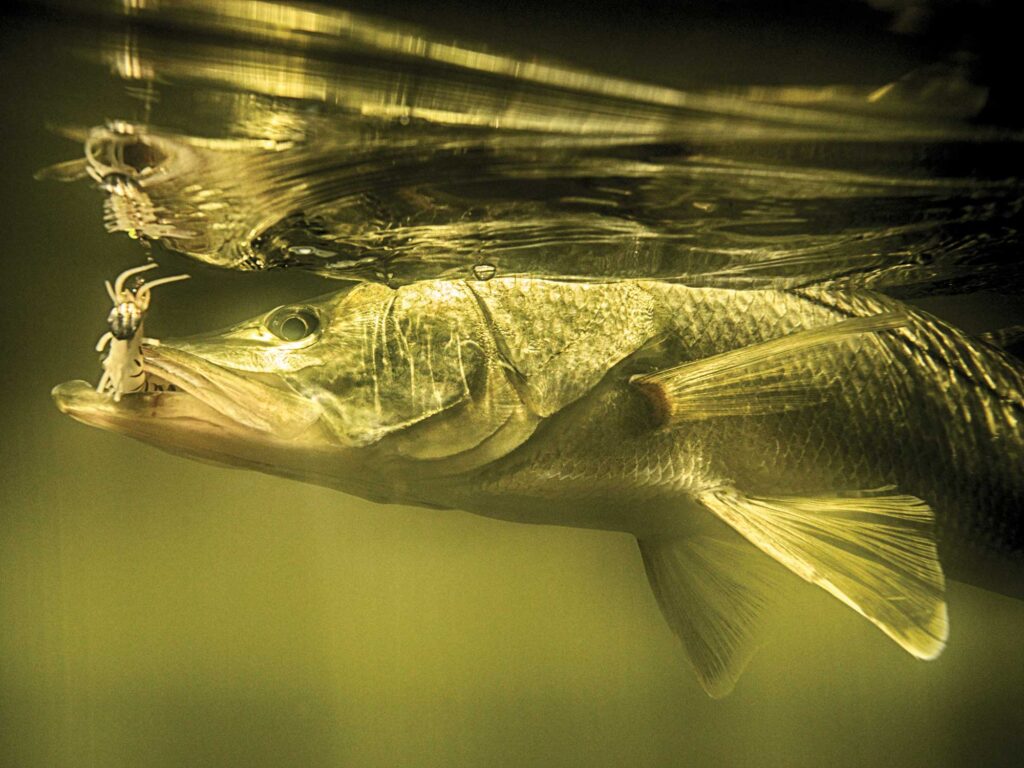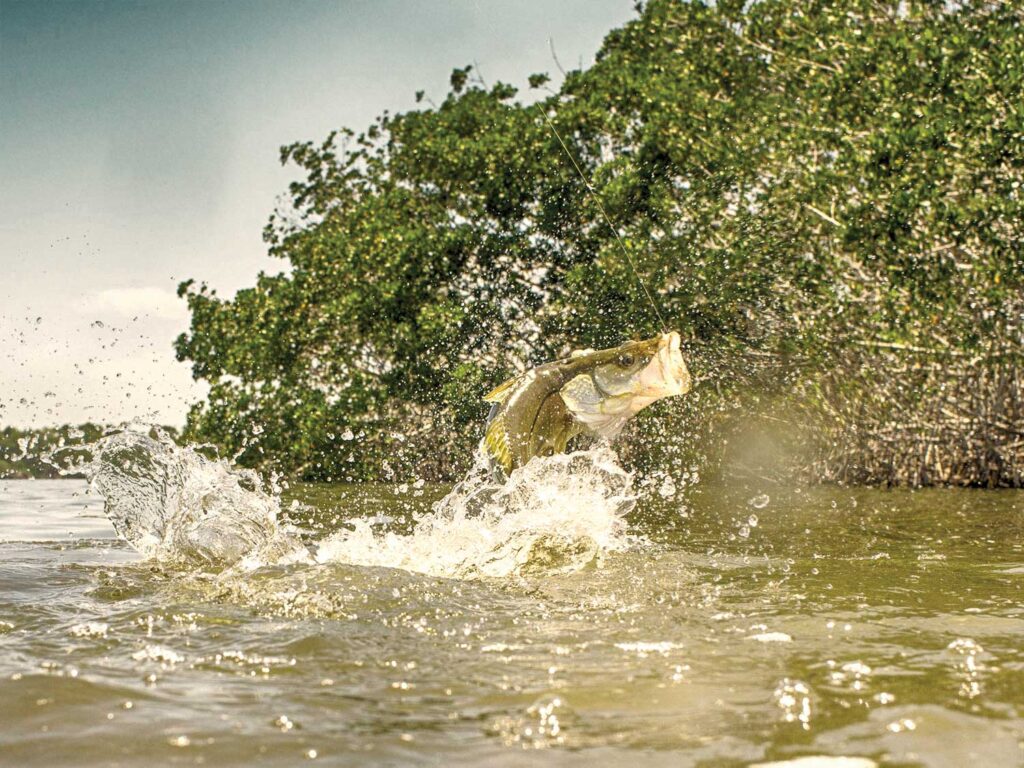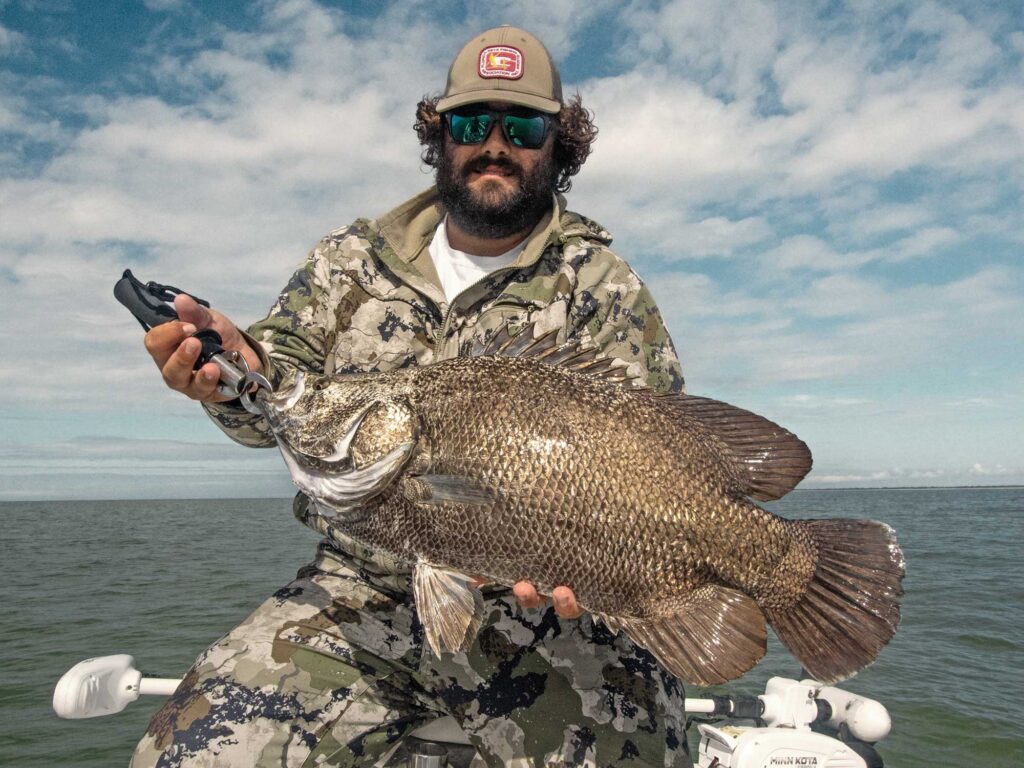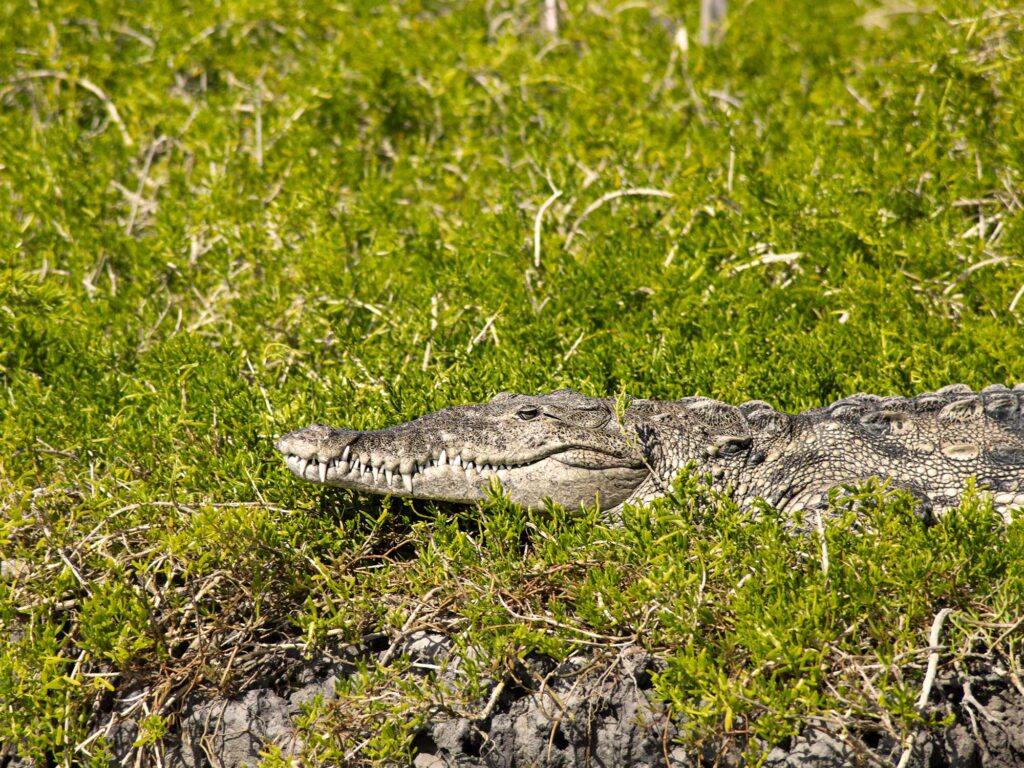
Anglers now have a relaxing overnight spot to stay in the far south of the Everglades, where fresh water meets salt. Flamingo has always been an ideal launch point for flats and backcountry anglers destined to fish places such as East Cape, the productive flats and mangrove keys of Florida Bay, or backcountry waters. But there was a drawback—the day didn’t end after the fishing was over. Invariably, DIY anglers always had to trailer their boats back north to Miami or make a run across Florida Bay to the Florida Keys.
That’s changed with the recently reopened and reimagined Flamingo Lodge. Today, anglers have the easy choice to stay at one of 24 air-conditioned rooms, plus more adventurous options such as houseboats, eco-tents (glamping), camping or RV sites. Now when the fishing is over, the relaxing can begin.
“The major renovations to the lodge incorporated energy–efficient features to meet Florida building codes for coastal high-hazard zones,” says Allyson Gantt, chief of communications and public affairs for Everglades National Park. In fact, the rooms were built from recycled materials and sit high off the ground, -requiring stairs or a ramp to reach them.
Old-timers will tell you the lodge wasn’t always this bulletproof. In 2005, hurricanes Katrina and Wilma destroyed the original Flamingo Lodge, the only motel to ever open in Florida’s Everglades National Park. That lodge, complete with an in-ground pool, opened in the 1960s and had a great run. “The original design had deficiencies, which we aimed to correct in the new lodge construction, using features such as shipping containers for their durability and elevating the rooms with an eye to sea-level rise,” says Gantt.
The nearly 20-year gap without a place to stay in Flamingo is over. And I was excited to visit. Traveling from Orlando, I hopped on a Brightline high-speed passenger train (max speeds of 125 to 135 mph) that dropped me off in downtown Miami. From there, I booked an Avis rental car to drive the final two hours of my journey. (Important note to those unfamiliar: The entrance of Everglades National Park in Homestead is still 40 miles away from Flamingo.) I was ecstatic to have a comfortable room to conk out for the night.

Spotlight on Snook
The next morning, Capt. Shawn MacMullin, of Prime Time Fishing Charters, met myself and Bill Kearney, of the South Florida Sun Sentinel, at the Flamingo Marina docks at 8 a.m. In January, there’s no reason to race the sun to your first fishing spot. Plus, MacMullin keeps his boat next to the Lorelei Restaurant in Islamorada, so he made a 50-minute run across Florida Bay to meet us.
“I’ve been on a good snook bite, plus we caught some big tripletail yesterday,” MacMullin said. “Does that sound good to you all?” A rhetorical question doesn’t need an answer—everyone loves catching snook and giant tripletail. After a quick boat ride on MacMullin’s Pathfinder, we started working a mangrove edge of a small key, not far from the marina.
Both Kearney and I will pick up an artificial before live bait.MacMullin respected that mindset, but he mentioned “jumbo live shrimp hooked through the horn on a jig head” were going to out-fish anything else in the current conditions. And the 23-year-old captain wasn’t lying. Shrimp were running at night, so most gamefish were snubbing anything that didn’t look or smell like one.
At the bow of the boat, I hooked into two decent snook pretty quickly, with one in the slot limit. I tightened down the drag on the bigger brute, testing MacMullin’s knots as the fish bolted for the spiderlike structure. I was able to turn the fish away, eventually leading it to a waiting net. In fact, as we played musical chairs throughout the morning, whoever was in front had a great chance to get bit, as long as your shrimp landed underneath the overhangs; then just let the bait fall slowly and start the retrieve.
“I have plenty of customers who can’t get their baits close enough to the mangroves, or they’ll cast into the mangroves and get tangled,” MacMullin explained. “They tend to catch -mostly small mangrove snapper that way.”
With 10 fish landed between us three pretty quickly, most of them much larger than the dinks MacMullin expects in numbers during the winter season, the day was already a success. The incoming tide slowed, and we completed the length of shoreline, so it was time to move on.
“There are so many keys out here—Clive Key, Frank Key and plenty of others—that all seem to have the same great [habitat],” MacMullin said. “Great depth, current and mangroves—and yet some of them won’t have a single snook or redfish on them, while other islands are loaded up. So, you sort of have to fish all the keys, finding out which shorelines are holding fish.”
The last shoreline we fished for snook was not fruitful, but Kearney still pulled a linesider from the mangroves using his trusty weedless-rigged jerkbait. As he was fighting the fish, a 5-foot lemon shark materialized from under the boat and swiped at it. We had no idea that shark was there moments before.
“The lemon sharks are really bad around here; I’m surprised we didn’t see any at the first spot with all those snook,” MacMullin said. “Summertime is the worst, but they are here all year.
“Check out all the teeth marks on my trolling motor. You have to fight your fish to the boat quickly. There’s no reviving the fish at the boat—don’t put your hands in the water. Net a fish quickly, unhook and shoot them back into the water. If I lose a snook or redfish to a shark, or I see a released fish get eaten by a shark, I change spots. There’s no reason to waste [these gamefish].”

A Taste of Tripletail
Up next was a run to the cape in search of tripletail on the stone crab traps; more specifically, the buoys that mark the traps. I was familiar with these traps, having caught tripletail there in spring. But apparently, the wintertime is also booming. The best way to describe the scene are long, straight lines of floats—like something an Olympic swimmer might swim laps in if taking a break from the pool. The lanes stack next to each other, headed toward the horizon.
“Some of these lines of traps have no tripletail on them,” MacMullin said, referring to the odd behavior ’tails exhibit, lying on their side behind a buoy like a giant leaf. “Anglers need to dial in the right depth—don’t go too far offshore or stay too close inshore. But they also need to find traps that have not been disturbed recently.”
From his boat tower, our captain scooted by a line of bright yellow buoys, looking for the brown fish with three distinctive fins. He favored the buoys not for their color, but because he knew a crabber hadn’t recently checked and reset the traps. (Tip: Check for marine growth on the buoys.) Every once in a while, we would come across a fish. In one instance, MacMullin made a cast with a live shrimp pinned to a weightless circle hook. He hooked and whipped the biggest tripletail of the day without ever leaving his tower.
I was a quick study. Sure, I flubbed my first chance, hooking the buoy and scaring off the fish. But that next opportunity, I was a tactician. I never lost track of the shrimp after casting far out in front of the buoy. Tripletail position headfirst into the tide, so I reeled my live shrimp across the surface and then let it sink right on its nose. Then it was on like Donkey Kong. The tripletail’s first run ended with a jump clear out of the water, which I can only describe as cute. Kearney eventually netted my fish, and with two now in the cooler, we headed to the dark-water creeks.
Read Next: Backcountry Boat Camping and Fishing in the Everglades

Venturing Into the Creeks
Using his Minn Kota, MacMullin positioned the Pathfinder at the mouth of different creeks, most of the cuts meandering inland to shallow-water lakes. This was the home of redfish, snook, sheepshead, black drum and juvenile goliath grouper.
“Have you ever seen a goliath grouper just sunning itself at the surface?” MacMullin asked. “It’s the weirdest thing. I’ve never seen them do it anywhere else. I don’t know why they do it. But their fins will stick out of the water, almost like a redfish.”
In some stretches, we’d float with the tide down the creek. In one spot, we waited where the creek met a lake, letting the tide bring the fish to us. My two boat mates swapped stories about exploring nearby cuts in their kayaks and Gheenoes as we drifted by yet another saltwater crocodile warming in the Florida winter sun. Don’t let anyone tell you crocodiles aren’t in the United States. Here, alligators dominate the fresh waters, while saltwater crocs rule the brine. One creek we fished had at least 10 different toothy critters relaxing fat and happy on the sidelines.
“This is another area where you really have to fight and release fish quickly,” MacMullin said. “There’s a lemon shark under our boat, guaranteed, even if we can’t see it.”
Picking away at fun-size snook, a sizable lemon made its presence known whenever we hooked a fish. We fought our quarry to the boat quickly and didn’t stay long at any spot. Our captain even had us release our fish as close to the mangrove edges as possible, giving them a fighting chance to survive. I basically lobbed one redfish to the other side of our small creek, just to release it away from the jacked-up shark.
On our run back to Flamingo Lodge, MacMullin mentioned a flock of flamingos he spotted the day before. (Apparently, a gathering of flamingos is actually called a “flamboyance,” something I learned at a zoo, which still sounds fishy to me.)
“I’ve fished here my whole life and saw my first flamingo in the wild two years ago,” he said. Since then, he’s seen more, and this recent group of pink feathered long legs was a good size. More than 100 years ago, the American flamingo basically disappeared from southern Florida, due to plume hunting and making meals of the birds.
Cruising out of Middle Cape Canal, we looked out toward the belly of Lake Ingraham. I saw a distant pink blur. “Could that be them?” I asked out loud. Almost immediately, everyone else saw it too. We changed course and went to explore.
Slowly pulling near the sandbar, the flamingos didn’t mind us getting close. The mix of sizes and different shades of pink stood out. I’ve spotted plenty of another pink bird in the Sunshine State—the roseate spoonbill—but this was the first time I’d ever seen flamingos in the wilds of Florida. One theory was that prior hurricanes knocked flamingos off course in Mexico and Belize, leading some lost birds to Florida. We eventually left the birds, fishing a bit in the saltwater lake before exiting out East Cape Canal. I thought to myself, Even the flamingos have returned to Flamingo.

About Flamingo Lodge
Hire a fishing guide like Capt. Shawn MacMullin (fishprimetime.com) when visiting Flamingo Lodge. The lodge totals 24 rooms, with options for studios and one- or two-bedroom suites. Additionally, four of the 24 rooms are ADA-accessible via elevator or walkway. The interiors of the rooms do not look like shipping containers; they’re pleasant, with shades of blues and greens, all with an eastward-facing balcony looking toward Florida Bay. Be warned: There are no TVs in the rooms.
Connected to the lodge, the Flamingo Restaurant offers meal service for breakfast, lunch and dinner, plus a full-service bar. Expect basics like burgers and salads, but also fresh-fish options. Of course, they’ll cook your catch too. We were the first ones to try their catch-and-cook option, savoring our fresh-caught tripletail prepared blackened, fried and grilled.
Room prices vary depending on the time of year. A park entrance fee or national park pass is required to enter Everglades National Park, both for vehicles and vessels. That’s right—you can boat to Flamingo instead of driving, with fuel and boat slips available at the nearby Flamingo Marina and store.
Anyone not fishing can still explore the many hiking and paddling trails, available off the main drag of SR 9336 inside the park. There’s Nine Mile Pond, Hell’s Bay and West Lake Loop for kayakers, and Snake Bight, Rowdy Bend and Christian Point for hikers. And that’s just a few of the options. Whatever you do, don’t forget the bug spray and lightweight long sleeves. For more information, visit flamingoeverglades.com and nps.gov/ever/planyourvisit.









